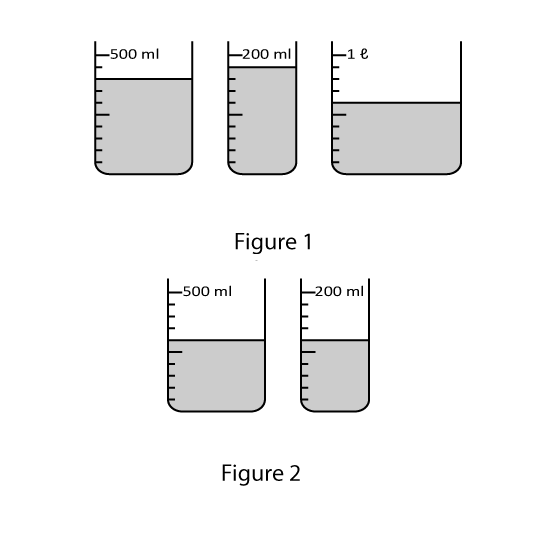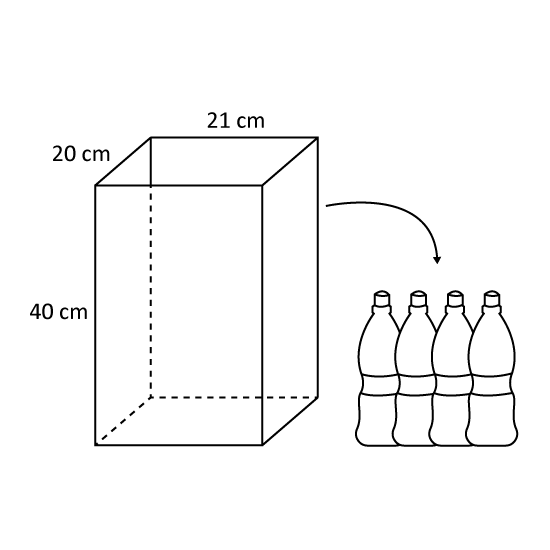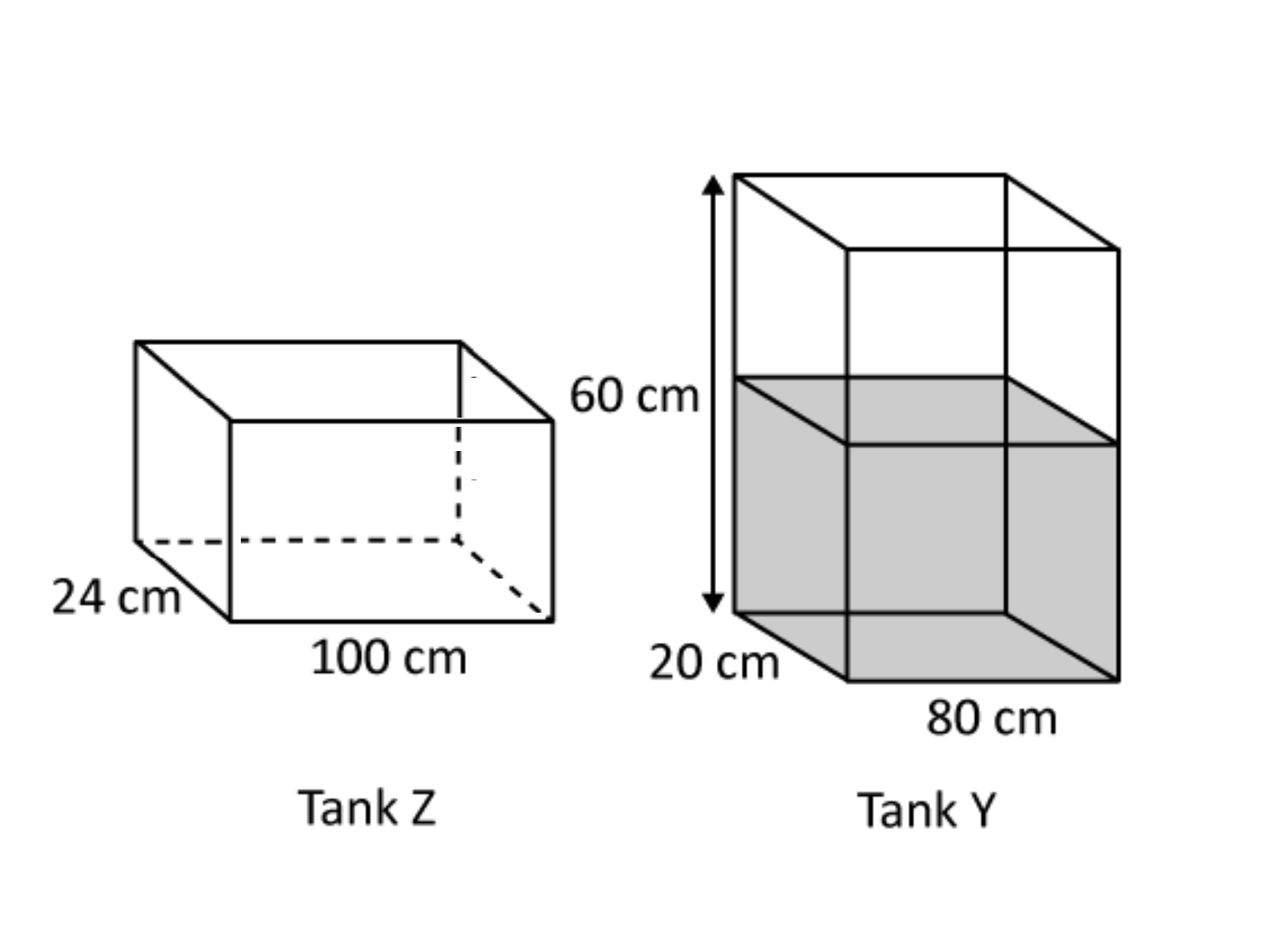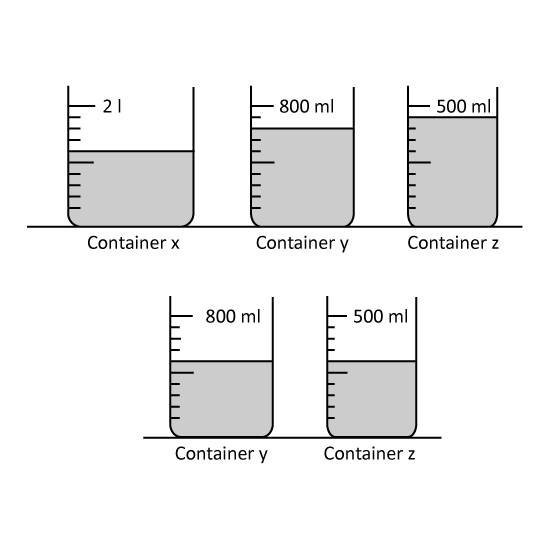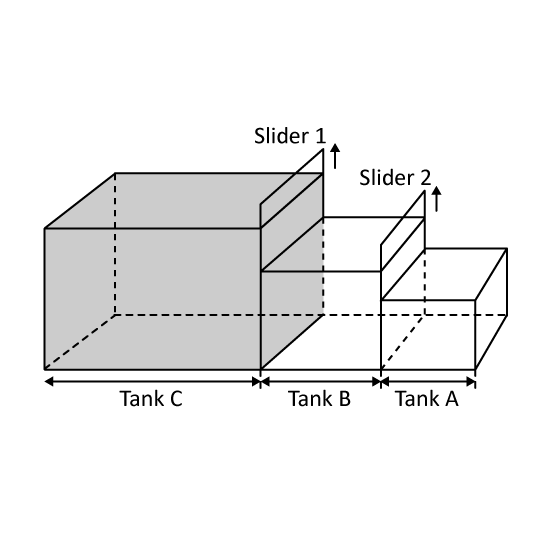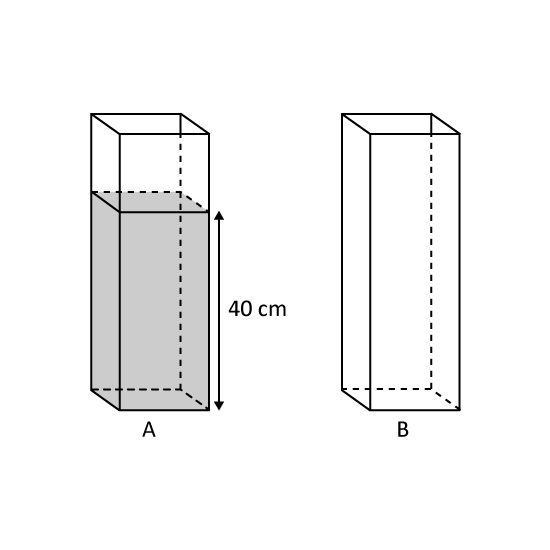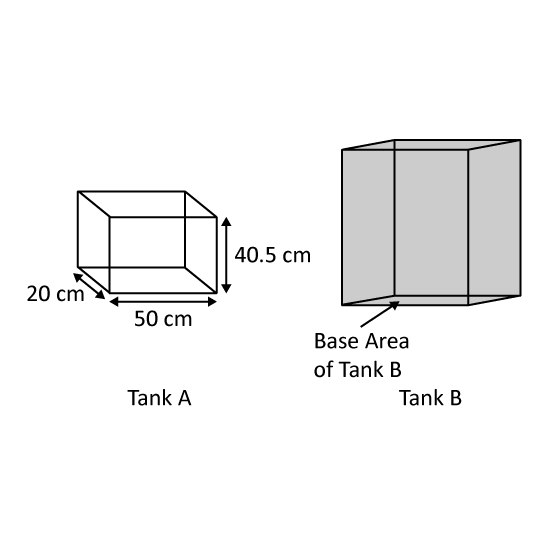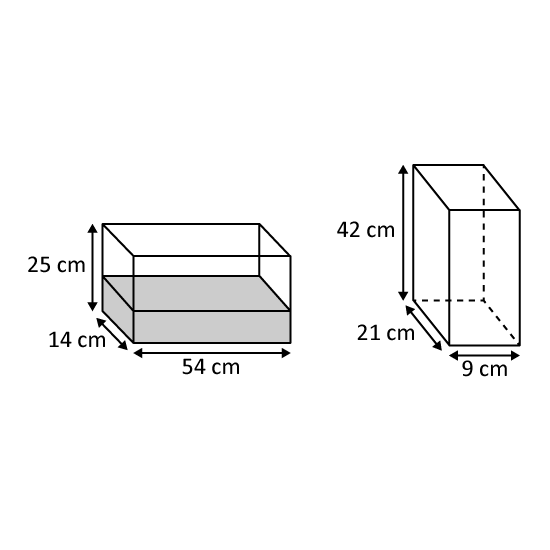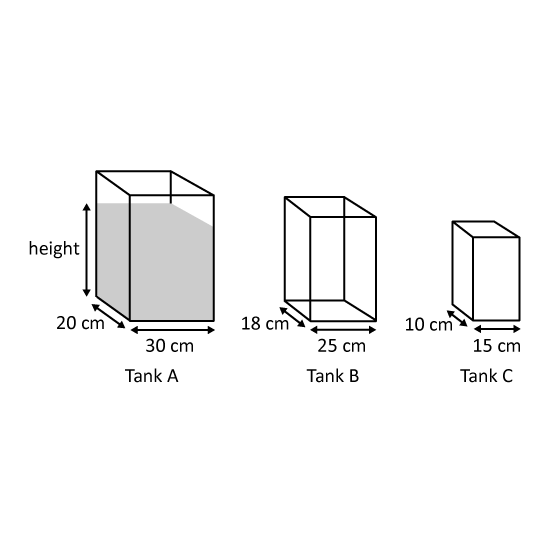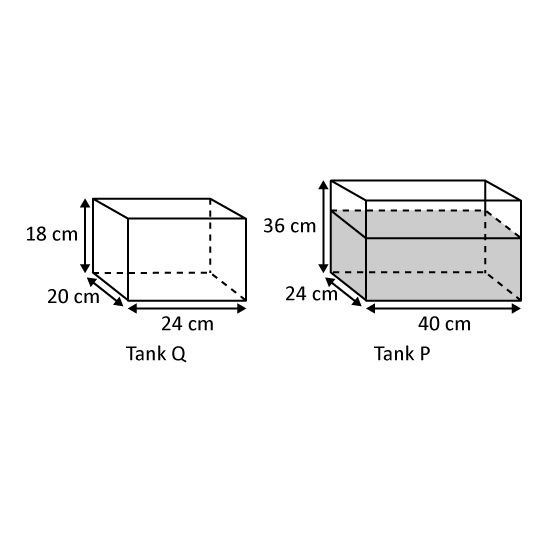Level 2
Mr Lee poured 4 cups of water into an empty square-based container of side 10 cm and height 20 cm. As a result, the container was only 14 filled with water. How much water did each cup contain?
2 m
Image in this question is not available.
Level 2 PSLE
At first, Containers A, B and C contained water as shown in Figure 1. Some water from A and B was poured into Container C without spilling. The amount of water left in Container A and B is shown in Figure 2. What would be the amount of water in Container C?
Level 2 PSLE
At first, Containers A, B and C contained water as shown in Figure 1. Some water from A and B was poured into Container C without spilling. The amount of water left in Container A and B is shown in Figure 2. What would be the amount of water in Container C?
Image in this question is not available.
Level 2
A cylindrical container is filled with 68.02 ℓ of water. It was then poured into an empty rectangular fish tank measuring 80 cm by 0.5 m by 28 cm until it is 47 full. How much water is left in the cylindrical container? Leave your answer in ℓ and mℓ.
2 m
Image in this question is not available.
Level 2
A rectangular container measuring 20 cm by 40 cm by 15 cm is 25 filled with water. Tom wants to fill up the container completely with some bottles of water. How many bottles of water are needed if the capacity of each bottle is 900 mℓ?
2 m
Image in this question is not available.
Level 2 The tank, measuring 21 cm by 20 cm by 40 cm, is
34 filled with water at first. All the water is poured into empty identical bottles to the brim. Each bottle has a capacity of 700 mℓ.
- How much water was there in the tank at first? Give your answer in millilitres.
- How many such bottles are completely filled with water?
Level 2 The tank, measuring 21 cm by 20 cm by 40 cm, is
34 filled with water at first. All the water is poured into empty identical bottles to the brim. Each bottle has a capacity of 700 mℓ.
- How much water was there in the tank at first? Give your answer in millilitres.
- How many such bottles are completely filled with water?
Image in this question is not available.
Level 3
Shemy placed three empty tanks side by side. The smallest tank has a crack at its side and the base area of each tank is 16 cm2. After she turned on the tap for 64 minutes, the height of the water in the smallest tank became 6 cm although 0.5 mℓ of water is leaking out of the crack per minute. Find the rate of flow of water from the tap. Give the answer in mℓ/min.
Level 3
Shemy placed three empty tanks side by side. The smallest tank has a crack at its side and the base area of each tank is 16 cm2. After she turned on the tap for 64 minutes, the height of the water in the smallest tank became 6 cm although 0.5 mℓ of water is leaking out of the crack per minute. Find the rate of flow of water from the tap. Give the answer in mℓ/min.
Image in this question is not available.
Level 2 PSLE
Two rectangular tanks are shown. Tank Y contained water to half its height. All the water from Tank Y was poured into Tank Z without spilling. What was the height of the water level in Tank Z?
Level 2 PSLE
Two rectangular tanks are shown. Tank Y contained water to half its height. All the water from Tank Y was poured into Tank Z without spilling. What was the height of the water level in Tank Z?
Image in this question is not available.
Level 2 PSLE
At first, Containers X, Y and Z contained water as shown. Some water from Containers Y and Z was poured into Container X without any spilling over. The amount of water left in Containers Y and Z is shown. What would be the amount of water in Container X?
Level 2 PSLE
At first, Containers X, Y and Z contained water as shown. Some water from Containers Y and Z was poured into Container X without any spilling over. The amount of water left in Containers Y and Z is shown. What would be the amount of water in Container X?
Image in this question is not available.
Level 3
A tank with a square base area of 121 cm2 is 60% filled with water. If 4 pails of water are poured into the tank, 756 cm3 of water would overflow. If 3 pails of water are poured into the tank, 128 cm3 of water would overflow. What is the height of the tank ? Give the answer to one decimal place.
3 m
Image in this question is not available.
Level 3
The diagram shows 3 containers of different dimensions, each separated by a partition. Tank C, measuring 20 m by 15 m by 21 m, is filled with water to its brim. Tank B is an empty cuboidal container with a length of 10 m. Slider 1 is lifted to release
14 of the water from Tank C to Tank B, after which the partition is slid down to separate Tank C and Tank B. Next, Slider 2 is removed and some water from Tank B flows into Tank A such that the height of the water level of Tank B and Tank A is 7 m.
- What is the length of Tank A?
- How many m3 of water are there in Tank B?
Level 3
The diagram shows 3 containers of different dimensions, each separated by a partition. Tank C, measuring 20 m by 15 m by 21 m, is filled with water to its brim. Tank B is an empty cuboidal container with a length of 10 m. Slider 1 is lifted to release
14 of the water from Tank C to Tank B, after which the partition is slid down to separate Tank C and Tank B. Next, Slider 2 is removed and some water from Tank B flows into Tank A such that the height of the water level of Tank B and Tank A is 7 m.
- What is the length of Tank A?
- How many m3 of water are there in Tank B?
Image in this question is not available.
Level 3
A tank, 110 cm by 100 cm by 70 cm, was completely filled with water. It was used to fill 16 bottles, each 3 litres in capacity. What was the height of the water left in the tank after all the bottles were filled. Round off to whole number.
3 m
Image in this question is not available.
Level 3
34 of a rectangular tank, 90 cm by 8 cm by 5 cm, is filled with water. A cubical container of edge 18 cm is filled with water to a depth of 15 cm. If the water in the rectangular tank is transferred to the cubical container until it is filled to its brim, how many litres of water will be left in the rectangular tank?
3 m
Image in this question is not available.
Level 3 PSLE
A and B are two rectangular tanks. The base area of A is 80 cm
2 while that of B is 50 cm
2 . At first, A contained water to a height of 40 cm and B was empty, as shown.
- What was the volume of the water in A at first?
- Rashid then poured some water from A to B. After that, the height of the water level in A was twice that in B. What was the new height of the water level in A? Round off the answer to 1 decimal place.
Level 3 PSLE
A and B are two rectangular tanks. The base area of A is 80 cm
2 while that of B is 50 cm
2 . At first, A contained water to a height of 40 cm and B was empty, as shown.
- What was the volume of the water in A at first?
- Rashid then poured some water from A to B. After that, the height of the water level in A was twice that in B. What was the new height of the water level in A? Round off the answer to 1 decimal place.
Image in this question is not available.
Level 3
The figure is not drawn to scale. An empty Tank A measures 50 cm by 20 cm by 40.5 cm. Tank B with a base area of 1000 cm2was completely filled with water. Ronald poured 12 of the water from Tank B into Tank A. The water filled 70% of Tank A. What was the height of Tank B? (Correct the answer to 2 decimal places.)
Level 3
The figure is not drawn to scale. An empty Tank A measures 50 cm by 20 cm by 40.5 cm. Tank B with a base area of 1000 cm2was completely filled with water. Ronald poured 12 of the water from Tank B into Tank A. The water filled 70% of Tank A. What was the height of Tank B? (Correct the answer to 2 decimal places.)
Image in this question is not available.
Level 3
A rectangular tank measuring 35 cm by 26 cm by 12 cm is completely filled with oil. Oil from the tank is poured into an empty cubical container of edge 18 cm until the cubical container is half-filled. What is the height of the oil in the tank after some oil is poured out? Correct the answer to 1 decimal place.
3 m
Image in this question is not available.
Level 3
The figure shows two tanks. 25% of Tank A is filled with water. Some of this water is then poured from Tank A to Tank B without spilling. The heights of the water level in both tanks are now equal. Find the height of the water level in Tank A after pouring.
Level 3
The figure shows two tanks. 25% of Tank A is filled with water. Some of this water is then poured from Tank A to Tank B without spilling. The heights of the water level in both tanks are now equal. Find the height of the water level in Tank A after pouring.
Image in this question is not available.
Level 3
The figure is not drawn to scale. Tank A is filled with water to a height of 10 cm. The water in Tank A is poured into 2 rectangular tanks, Tank B and Tank C, such that the heights of the water in the 3 tanks are equal. Find the volume of water poured out of Tank A in litres.
Level 3
The figure is not drawn to scale. Tank A is filled with water to a height of 10 cm. The water in Tank A is poured into 2 rectangular tanks, Tank B and Tank C, such that the heights of the water in the 3 tanks are equal. Find the volume of water poured out of Tank A in litres.
Image in this question is not available.
Level 3
Water flows into a tank at the rate of 45 ℓ per minute. After 10 min, the tap is turned off and the tank is 0.6 filled with water.
- How much more water is needed to fill it to the brim?
- The water in the tank is then poured into containers each 1.5 m long, 0.3 m wide and 10 cm high. What is the minimum number of containers needed?
4 m
Image in this question is not available.
Level 3
Tank P measuring 40 cm by 24 cm by 36 cm is 56-filled with water. The water is then poured into another tank, Tank Q measuring 24 cm by 20 cm by 18 cm until it is full. What is the volume of water left in Tank P? Give your answer in cubic centimetres.
Level 3
Tank P measuring 40 cm by 24 cm by 36 cm is 56-filled with water. The water is then poured into another tank, Tank Q measuring 24 cm by 20 cm by 18 cm until it is full. What is the volume of water left in Tank P? Give your answer in cubic centimetres.
Image in this question is not available.
Level 3
Tank A is a cubical tank of side 8 cm. It is
34 filled with water. The water is then poured into Tank B measuring 10 cm by 12 cm by 15 cm.
- Find the volume of water in Tank A at first.
- How much more water is needed to fill Tank B to the brim? Give your answer in litres.
3 m
Image in this question is not available.
